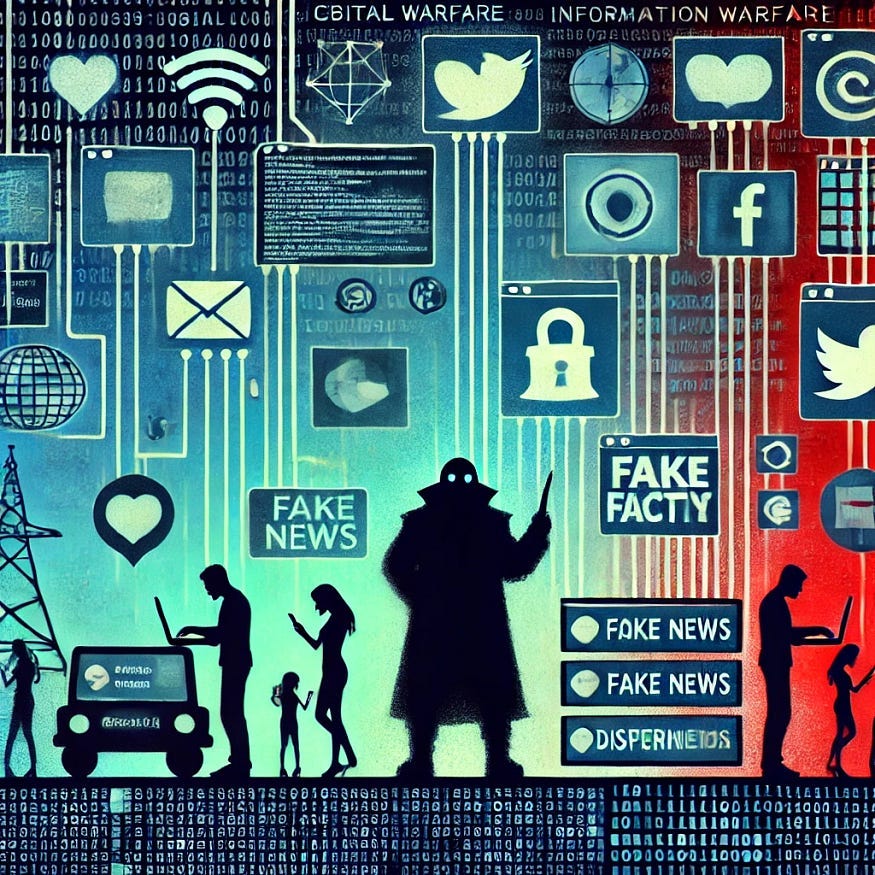The Digital Battlefield: Unraveling the Tactics of Modern Information Warfare
How Information Warfare Shapes Public Perception, Manipulates Narratives, and Threatens Democracy in the Age of Cyber Conflict.

What is Information Warfare?
Information Warfare refers to a range of operations conducted to gain an information advantage over an opponent. It involves several key activities:
Controlling One’s Own Information Space: Protecting access to one’s own information and ensuring that it is not manipulated or compromised by an adversary.
Acquiring and Using the Opponent’s Information: Gathering intelligence about an adversary’s plans, operations, and intentions.
Disrupting the Opponent’s Information Flow: Attacking or destroying the adversary’s information systems to hinder their ability to communicate and coordinate.
Destroying Information Systems: Directly targeting the technological infrastructure that supports the opponent’s information activities.
Information warfare is not new, but its methods and scale have evolved with technological advancements, allowing information to be disseminated faster and on a larger scale.
Key Components of Information Warfare
1- Cyberwarfare:
Cyberspace provides a significant arena for information warfare. Cyberwarfare can involve direct attacks on an adversary’s information systems or infrastructure, as well as social cyber-attacks designed to shape public perception and opinion to align with the goals of the information warfare campaign. For example, creating a specific narrative or image of the world in people’s minds that supports the objectives of the country conducting the information warfare.
2- The Internet as a Battleground:
The internet expands the possibilities for both defending one’s own information and disrupting the information of opponents. Social media platforms play a crucial role in these efforts due to their speed, wide coverage, and low cost. Information warfare tactics over the internet include:
Troll Factories: Entities employing people to post comments and content online in line with specific objectives, using fake profiles.
Bots: Automated programs that send out messages or comments in response to certain keywords or events.
Fake News: Deliberately misleading or false information designed to manipulate public perception.
3- Disinformation Campaigns:
Disinformation campaigns are a critical tool in information warfare, involving the deliberate dissemination of false or misleading information to deceive the public or manipulate opinions. Russia, for example, has used both traditional media and social media to spread its version of events, as seen in the annexation of Crimea and the ongoing Russian-Ukrainian conflict.
Implications for Media and Users
Journalists:
Journalists must navigate a complex landscape where they can be both the messengers and the targets of disinformation. Ensuring the accuracy of their reporting is crucial, as they often receive information that may be part of larger disinformation efforts.Media Users:
Consumers of media are increasingly aware of their potential exposure to propaganda and disinformation. Many are turning to alternative news sources to diversify their information and avoid “information bubbles,” where algorithms limit the range of content they see to only what aligns with their past behavior or preferences.
Growing Awareness of Information Warfare
Interest in information warfare has surged in recent years, particularly following events like the Russian annexation of Crimea in 2014. This conflict has highlighted how states use both traditional and digital platforms to influence public perception domestically and internationally. Countries like Russia have leveraged “troll factories” and social media campaigns to promote their own narratives and disrupt those of their adversaries, showcasing the evolving nature of information warfare in the digital age.
Conclusion
Information warfare, fueled by rapid technological advancements and the widespread reach of the internet, has become a sophisticated tool for modern conflicts. It leverages both traditional and digital media to manipulate perceptions, spread disinformation, and achieve strategic objectives. Understanding and countering information warfare tactics is critical for maintaining public trust, protecting democratic institutions, and ensuring a more informed and resilient society.

